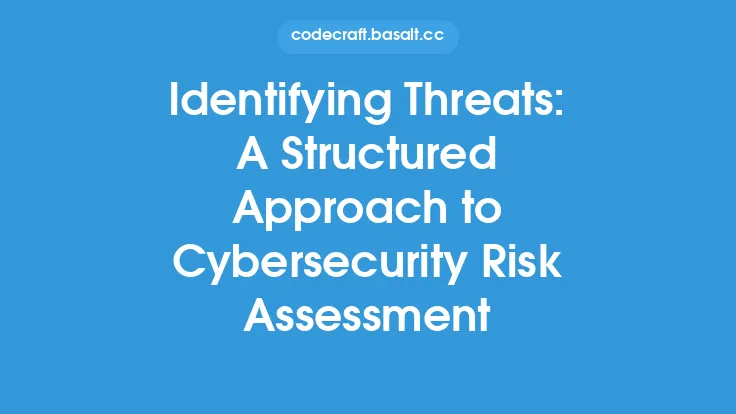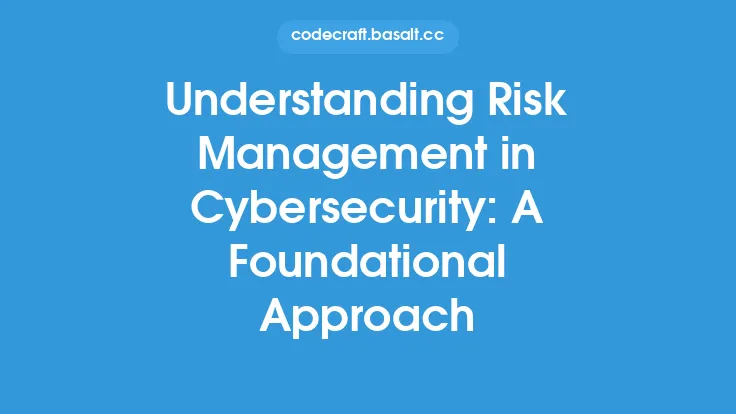Implementing a risk-based approach to cybersecurity is a crucial step in protecting an organization's assets and data from potential threats. This approach involves identifying, assessing, and mitigating risks to ensure the confidentiality, integrity, and availability of sensitive information. A risk-based approach to cybersecurity is essential in today's digital landscape, where threats are becoming increasingly sophisticated and frequent.
Introduction to Risk-Based Cybersecurity
A risk-based approach to cybersecurity is a proactive strategy that focuses on identifying and mitigating potential risks before they can cause harm. This approach involves a thorough analysis of an organization's assets, threats, vulnerabilities, and likelihood of a security breach. By understanding the potential risks and their impact, organizations can prioritize their security efforts and allocate resources effectively. A risk-based approach to cybersecurity is not a one-time task, but an ongoing process that requires continuous monitoring and evaluation.
Key Components of a Risk-Based Approach
There are several key components of a risk-based approach to cybersecurity, including:
- Risk Identification: This involves identifying potential risks to an organization's assets, including data, systems, and networks. Risk identification can be done through various methods, such as vulnerability scanning, penetration testing, and threat intelligence.
- Risk Assessment: This involves evaluating the likelihood and potential impact of identified risks. Risk assessment can be done using various methodologies, such as quantitative or qualitative risk assessment.
- Risk Mitigation: This involves implementing controls and countermeasures to reduce the likelihood or impact of identified risks. Risk mitigation can include various measures, such as firewalls, intrusion detection systems, and encryption.
- Risk Monitoring: This involves continuously monitoring an organization's assets and systems to detect potential security breaches. Risk monitoring can be done using various tools and techniques, such as log analysis, network monitoring, and security information and event management (SIEM) systems.
Implementing a Risk-Based Approach
Implementing a risk-based approach to cybersecurity requires a structured methodology. The following steps can be followed:
- Establish a Risk Management Framework: This involves defining a risk management framework that outlines the organization's risk management policies, procedures, and standards.
- Identify and Classify Assets: This involves identifying and classifying an organization's assets, including data, systems, and networks.
- Conduct a Risk Assessment: This involves conducting a risk assessment to identify potential risks to an organization's assets.
- Prioritize Risks: This involves prioritizing identified risks based on their likelihood and potential impact.
- Implement Risk Mitigation Measures: This involves implementing risk mitigation measures to reduce the likelihood or impact of identified risks.
- Continuously Monitor and Evaluate: This involves continuously monitoring and evaluating an organization's assets and systems to detect potential security breaches and evaluate the effectiveness of risk mitigation measures.
Technical Controls for Risk Mitigation
Technical controls play a crucial role in risk mitigation. Some common technical controls include:
- Firewalls: Firewalls can be used to block unauthorized access to an organization's networks and systems.
- Intrusion Detection Systems: Intrusion detection systems can be used to detect potential security breaches and alert security teams.
- Encryption: Encryption can be used to protect sensitive data from unauthorized access.
- Access Control: Access control can be used to restrict access to an organization's assets and systems.
- Vulnerability Management: Vulnerability management involves identifying and remediating vulnerabilities in an organization's systems and applications.
Operational Controls for Risk Mitigation
Operational controls are also essential for risk mitigation. Some common operational controls include:
- Security Policies: Security policies can be used to outline an organization's security procedures and standards.
- Security Awareness Training: Security awareness training can be used to educate employees on security best practices and procedures.
- Incident Response Planning: Incident response planning involves developing a plan to respond to potential security breaches.
- Continuous Monitoring: Continuous monitoring involves continuously monitoring an organization's assets and systems to detect potential security breaches.
- Compliance: Compliance involves ensuring that an organization's security practices and procedures comply with relevant laws and regulations.
Benefits of a Risk-Based Approach
A risk-based approach to cybersecurity offers several benefits, including:
- Improved Security Posture: A risk-based approach can help improve an organization's security posture by identifying and mitigating potential risks.
- Reduced Risk: A risk-based approach can help reduce the likelihood and impact of potential security breaches.
- Cost Savings: A risk-based approach can help organizations allocate resources more effectively, resulting in cost savings.
- Regulatory Compliance: A risk-based approach can help organizations comply with relevant laws and regulations.
- Increased Confidence: A risk-based approach can help increase confidence in an organization's security practices and procedures.
Challenges and Limitations
Implementing a risk-based approach to cybersecurity can be challenging. Some common challenges and limitations include:
- Complexity: Implementing a risk-based approach can be complex, requiring significant resources and expertise.
- Cost: Implementing a risk-based approach can be costly, requiring significant investment in technology and personnel.
- Limited Resources: Small and medium-sized organizations may have limited resources, making it challenging to implement a risk-based approach.
- Evolving Threats: Cyber threats are constantly evolving, making it challenging to stay ahead of potential risks.
- Human Error: Human error can be a significant challenge, as employees may unintentionally introduce security risks.
Conclusion
Implementing a risk-based approach to cybersecurity is essential in today's digital landscape. By identifying, assessing, and mitigating potential risks, organizations can protect their assets and data from potential threats. A risk-based approach requires a structured methodology, technical controls, operational controls, and continuous monitoring and evaluation. While there are challenges and limitations to implementing a risk-based approach, the benefits of improved security posture, reduced risk, cost savings, regulatory compliance, and increased confidence make it a crucial investment for any organization.





